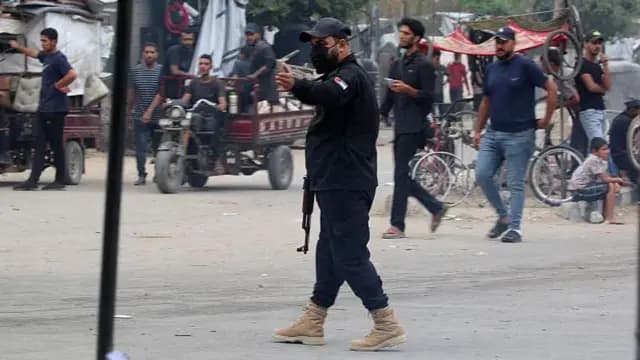Loading News Article...
We're loading the full news article for you. This includes the article content, images, author information, and related articles.
We're loading the full news article for you. This includes the article content, images, author information, and related articles.
At least 27 people have been killed in fierce internal fighting in Gaza City, marking one of the most violent confrontations since major Israeli military operations ceased. The clashes highlight ongoing power struggles and security challenges within the enclave.

Gaza City witnessed intense internal fighting on Saturday, October 11, 2025, as Hamas security forces clashed with armed members of the influential Dughmush family. The confrontations, which erupted in the Tel al-Hawa neighborhood near the former Jordanian Hospital, resulted in the deaths of at least 27 people. Eyewitnesses reported masked Hamas gunmen exchanging heavy fire with clan fighters, causing widespread panic and forcing dozens of families to flee their homes.
A senior official from the Hamas-run interior ministry confirmed that its forces surrounded the area to detain what it described as a "militia" engaged in armed activity outside the purview of the resistance. The ministry reported that eight of its personnel were killed in what it termed an "armed assault." Medical sources indicated that 19 members of the Dughmush clan also died in the confrontation.
The clashes reportedly began after two members of Hamas's elite forces, including the son of a senior commander in Hamas's military intelligence, were shot dead by Dughmush clan gunmen in Gaza City's Sabra neighbourhood. Hamas had recently recalled approximately 7,000 members of its security forces to reassert control over the Gaza Strip following the withdrawal of Israeli forces from urban positions by October 10, 2025.
The Dughmush clan is one of Gaza's largest and most influential families, with a history of involvement with various Palestinian and Islamist groups, including Fatah, Hamas, and Al-Qaeda. The clan has frequently been involved in violent clashes with Hamas security forces since Hamas took control of Gaza in 2007.
Past confrontations include a September 2008 incident where 12 people were killed after Hamas raided a Dughmush stronghold following the killing of a Hamas policeman. The clan has also been linked to criminal activities such as extortion, smuggling, and arms dealing, and was responsible for the kidnapping of British journalist Alan Johnston in 2007.
Hamas's current efforts to re-establish control come amidst a power vacuum created by the recent Israeli withdrawal and an October 10, 2025, ceasefire. The group aims to "cleanse Gaza of outlaws and collaborators with Israel" and has deployed armed units, some in civilian clothing, to patrol districts across Gaza City.
The Hamas interior ministry has defended its actions, stating the operation aimed to restore law and order and warning that "any armed activity outside the framework of the resistance will be dealt with decisively." This stance underscores Hamas's determination to maintain its authority in the Gaza Strip, which it has governed since 2007.
The recent ceasefire agreement, brokered under the guidance of former US President Donald Trump, is the first phase of a comprehensive peace initiative. However, the agreement does not explicitly address the long-term governance of Gaza. Israeli Prime Minister Benjamin Netanyahu has stated he will not allow either Hamas or the Palestinian Authority to govern Gaza post-war, while Hamas has indicated it would accept a technocratic body emerging from internal dialogue with the PA but will not disarm.
Residents caught in the crossfire described scenes of terror, with one local stating, "This time, people weren't running from Israeli bombardments. They were fleeing from their own people." This sentiment highlights the profound impact of internal conflicts on a population already displaced multiple times during the recent war.
A Dughmush family source told local media that Hamas forces had arrived at a building that once served as the Jordanian Hospital, where family members had sought refuge after their homes were destroyed by Israeli strikes. The source alleged that Hamas intended to evict the family to establish a new base.
The renewed internal violence in Gaza raises concerns about the stability of the recently implemented ceasefire and the future governance of the Strip. Human rights advocate Khalil Abu Shammala cautioned that Hamas's efforts to maintain influence could "jeopardize the peace agreement and plunge Gaza's residents into even greater suffering."
Analysts suggest that the development could influence public debate and policy execution, with stakeholders urging clarity on timelines, costs, and safeguards for Gaza's future. The presence of numerous armed groups and a widespread availability of weapons in Gaza further exacerbates the risk of continued civil strife.
While Hamas accuses Dughmush gunmen of killing two of its members and wounding five others, prompting the raid, the Dughmush family has presented a different account, alleging Hamas sought to seize their refuge. The exact motivations and sequence of events leading to the intense escalation remain subject to conflicting narratives.
The long-term implications of Hamas's crackdown on rival clans and militias, particularly in the context of a post-ceasefire Gaza, are also uncertain. There are reports of Israel attempting to work with Gaza clans to create alternative governance structures, though some clans, including the Dughmush, have reportedly refused such overtures.
Observers will be closely watching how Hamas manages internal dissent and rival armed groups in the coming weeks, particularly as discussions about Gaza's future governance continue. The effectiveness of the ceasefire and the potential for further internal conflicts will largely depend on Hamas's ability to consolidate power without further destabilizing the already fragile humanitarian situation.
Keep the conversation in one place—threads here stay linked to the story and in the forums.
Other hot threads
E-sports and Gaming Community in Kenya
Active 6 months ago
Popular Recreational Activities Across Counties
Active 6 months ago
Investing in Youth Sports Development Programs
Active 6 months ago
The Role of Technology in Modern Agriculture (AgriTech)
Active 6 months ago